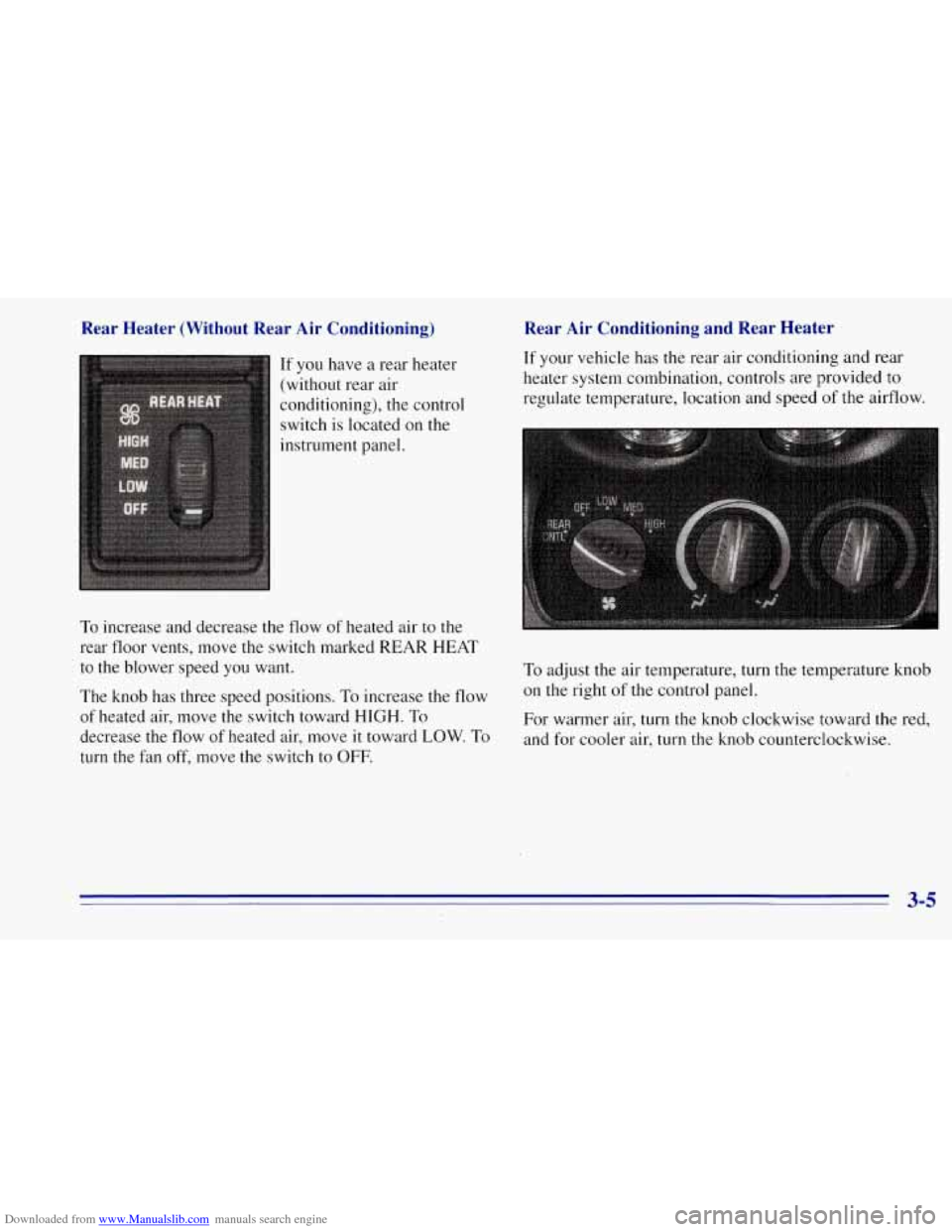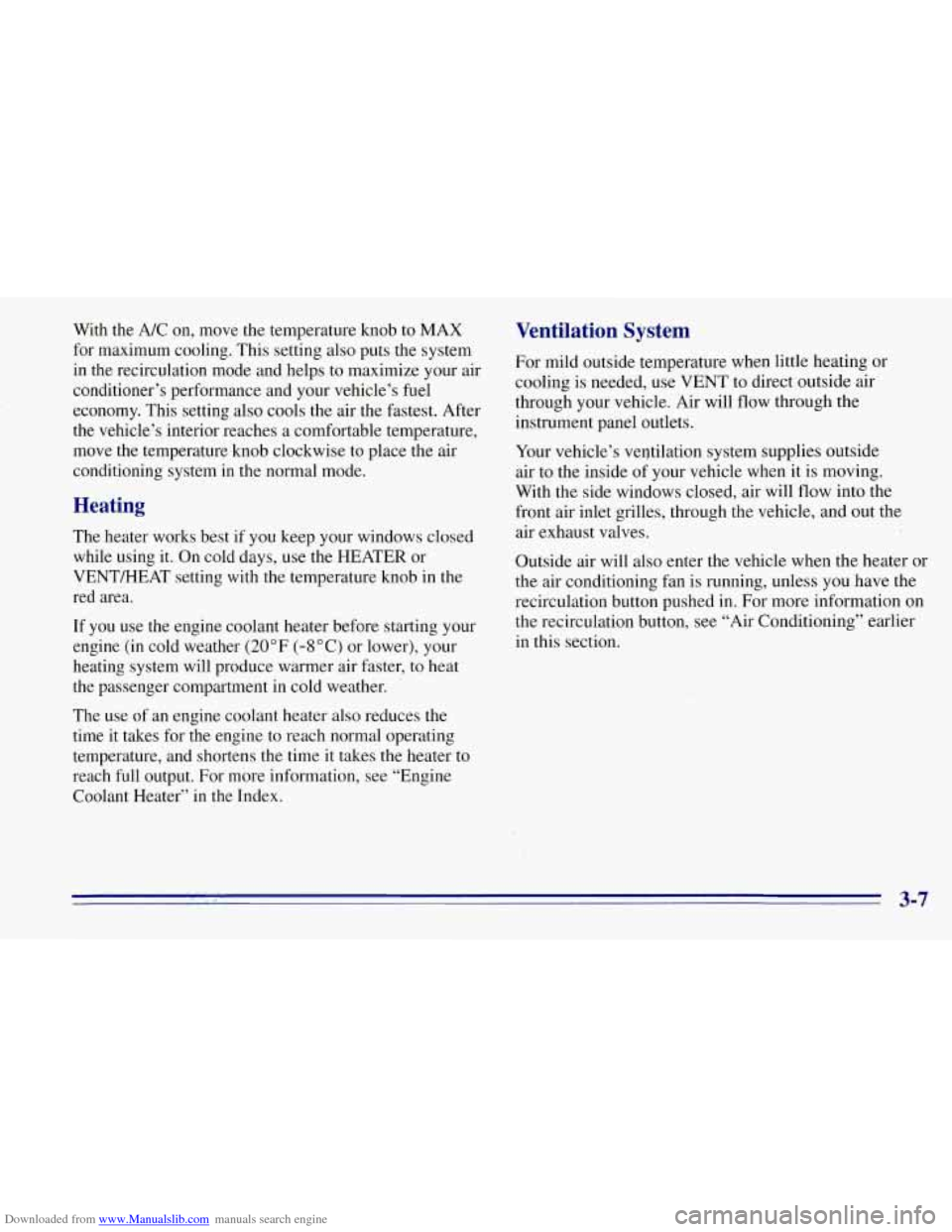1996 CHEVROLET TAHOE air conditioning
[x] Cancel search: air conditioningPage 134 of 403

Downloaded from www.Manualslib.com manuals search engine Temperature Knob
The middle knob on the control pane-1 lets you select
the relative temperature of the air flowing into the
passenger area of your vehicle. This knob will allow you
to adj.ust the relative air temperature independently of
the function knob setting, Move the knob clockwise
toward the red area for warmer air. Move the knob
counterclockwise toward the blue area for cooler air.
Mode Knob
The right knob on the control panel allows you to
choose the direction of air delivery. The control knob
can be placed in any position between any two mode
settings to blend the flow of air.
+e
# VENT This setting directs air through the
instrument panel outlets.
+’ VENTMEAT Use this setting to divide airflow.
between the floor outlets and instrument panel outlets.
+e
HEATER: This setting directs air through the
floor outlets.
+# DEFOG: This setting directs air to the heater
outlets and toward the windshield.
9 DEFROST This setting directs air toward
the windshield.
w.
Rear Air Conditioning and Heating Systems
(Suburban)
’
If your vehicle has either or both of these systems, you
can increase and decrease the airflow at the rear vents.
Depending on the system
you have and the setting
selected,
you can send cooled or heated air to the rear of
the vehicle.
Rear Air Conditioning (Without Rear Heater)
If your vehicle has rear air conditioning (without rear
heater), the controls are located above the front and
second seats. The front and rear overhead controls let
you increase and decrease the airflow at the rear vents.
To operate the rear air conditioning system, the front air
conditioning system must be on. With the front air
conditioning system off, the rear system controls can be
used to circulate air in the rear of the vehicle.
3-3
Page 136 of 403

Downloaded from www.Manualslib.com manuals search engine Rear Heater (Without Rear Air Conditioning)
If you have a rear heater
(without rear air
conditioning), the control
switch is located on the
instrument panel.
To increase and decrease the flow of heated air to the
rear floor vents, move the switch marked REAR HEAT
to the blower speed you want.
The knob has three speed positions. To increase the flow
of heated air, move the switch toward HIGH. To
decrease the
flow of heated air, move it toward LOW. To
turn the fan off, move the switch to OFF.
Rear Air Conditioning and Rear Heater
If your vehicle has the rear air conditioning and rear
heater system combination, controls are provided to
regulate temperature, location and speed
of the airflow.
To adjust the air temperature, turn the temperature knob
on the right of the control panel.
For warmer air, turn the knob clockwise toward the red,
and for cooler air, turn the knob counterclockwise.
3-5
Page 137 of 403

Downloaded from www.Manualslib.com manuals search engine To regulate the airflow location, adjust the center knob
on the control panel. Turn the knob clockwise for floor
vent airflow or counterclockwise for headliner vent
airflow. Generally, the upper vents are used for air
conditioning and the floor vents for heating. The control
knob can
be set to any blend setting.
To adjust the aifflow speed, turn the fan control knob
on the left side of the control panel to the desired
blower setting.
To activate the rear control, move the fan knob on the
front control
to REAR CNTL.
Air Conditioning
On hot days, open the windows long enough to let hot
air inside escape. This reduces the time it takes for your
vehicle to cool down. Then keep your windows closed
for the air conditioner to work its best.
The recirculation button, between the fan and temperature
knobs, allows the air inside your vehicle to be
recirculated. This setting helps to maximize your air
conditioner’s performance and your vehicle’s fuel
economy. This setting also cools the air the fastest and
can be used to keep unwanted odors and/or dust from
entering the vehicle. When using the air conditioner, turn
off recirculation after the vehicle reaches a comfortable
interior temperature. When the right knob on the control
panel is between HEATER and DEFROST, the
recirculation feature will not function.
The A/C button, between the temperature and mode
knobs, allows the air coming into your vehicle to be
cooled. This setting is useful for normal cooling on hot
days. When
you use A/C with the recirculation button
pushed in, turn off recirculation as soon as the vehicle
reaches a comfortable interior temperature.
The
rear control works just like the front control. It will
allow second seat passengers to adjust the controls as
they desire.
Page 138 of 403

Downloaded from www.Manualslib.com manuals search engine With the A/C on, move the temperature knob to MAX
for maximum cooling. This setting also puts the system
in the recirculation mode and helps to maximize your air
conditioner’s performance and your vehicle’s fuel
economy. This setting also cools the air the fastest. After
the vehicle’s interior reaches a comfortable temperature,
move the temperature knob clockwise to place the air
conditioning system in the normal mode.
The heater works best if you keep your windows closed
while using it. On cold days, use the HEATER or
VENT/HEAT setting with the temperature knob in the
red area.
If you use the engine coolant heater before starting your
engine (in cold weather (20°F (-8OC) or lower), your
heating system will produce warmer air faster, to heat
the passenger compartment in cold weather.
The use of an engine coolant heater also reduces the
time it takes for the engine to reach normal operating
temperature, and shortens the time it takes the heater to
reach full output. For more information, see “Engine
Coolant Heater” in the Index. Ventilation System
For mild outside temperature when little heating or
cooling is needed, use VENT to direct outside air
through your vehicle. Air will flow through the
instrument panel outlets.
Your vehicle’s ventilation system supplies outside
air to the inside
of your vehicle when it is moving.
With the side windows closed, air will flow into the
front air inlet grilles, through the vehicle, and out the
air exhaust valves.
Outside air will also enter the vehicle when the heater or
the air conditioning fan is running, unless you have the
recirculation button pushed in. For more information
on
the recirculation button, see “Air Conditioning” earlier
in this section.
- .. G 3-7
Page 218 of 403

Downloaded from www.Manualslib.com manuals search engine 2. Turn off the ignition on both vehicles. Turn off all
lamps that aren’t needed, and radios. This will avoid
sparks and help save both batteries. And it could
save your radio!
NOTICE: I
If you leave your radio on, it could be badly
damaged. The repairs wouldn’t be covered by
your warranty.
3. Open the hoods and locate the batteries’. Find
the positive
(+) and negative (-) terminals on
each battery.
A CAUTION:
If your vehicle has air conditioning, the auxiliary
electric fan under the hood can start up even
when the engine is not running and can injure
you. Keep hands, clothing and tools away from
any underhood electric fan.
~
A CAUTION:
-
Using a match near a battery can cause battery
gas to explode. People have been hurt doing this,
and some have been blinded. Use a flashlight if
you need more light.
Be sure the batteries have enough water. You
don’t need to add water to the Delco Freedom@
battery (or batteries) installed in every new
GM
vehicle. But if a battery has filler caps, be sure
the right amount of fluid is there.
If it is low, add
water to take care of that first.
If you don’t,
explosive
gas could be present.
Battery fluid contains acid that can burn
you.
Don’t get it on you. If you accidentally get it in
your eyes or on your skin, flush the place with
water and get medical help immediately.
5-3
Page 226 of 403

Downloaded from www.Manualslib.com manuals search engine Cooling System -- Gasoline Engines
When you decide it’s safe to lift the hood, here’s what
you’ll see:
A. Coolant Recovery Tank
B. Radiator Pressure Cap
C. Engine Fan(s)
A CAUTION: I
If your vehicle has air conditioning, the auxiliary
electric fan under the hood can start up even
when the engine
is not running and can injure
you. Keep hands, clothing and tools away from
any underhood electric fan.
If the coolant inside the coolant recovery tank is boiling,
don’t do anything else until it cools down.
5-11
Page 259 of 403

Downloaded from www.Manualslib.com manuals search engine Be careful not to spill gasoline. Clean gasoline from
painted surfaces as soon as possible. See “Cleaning the
Outside of Your Vehicle” in
the Index.
When you put the cap back on, turn it to the right until
you hear at least three clicks. Make sure you fully install
the cap. The diagnostic system can determine if the fuel
cap
has been left off or improperly installed. This would
allow fuel to evaporate into the atmosphere. See
“Malfunction Indicator Lamp” in the Index.
NOTICE:
If you need a new cap, be sure to get the right
type. Your dealer can get one for you.
If you get
the wrong type, it may not
fit or have proper
venting, and your fuel tank and emissions system
might be damaged.
Checking Things Under the Hood
A CAUTION:
If your vehicle has air conditioning, the auxiliary
engine fan under the hood can start up and
injure you even when the engine is not running.
Keep hands, clothing and tools
away from any
underhood electric fan.,
A CAUTION: 1
Things that burn can get on hot engine parts and
start a fire. These include liquids like gasoline or
diesel fuel,
oil, coolant, brake fluid, windshield
washer and other fluids, and plastic or rubber.
You
or others could be burned. Be careful not to drop
or spill things that
will burn onto a hot engine.
6-6
Page 260 of 403

Downloaded from www.Manualslib.com manuals search engine Hood Release
To open the hood,
first pull the handle
inside the vehicle.
.. .
I
Then go to the front of the vehicle and pull up on the
secondary hood release, located just to the passenger
side of the center of the grill.
Lift the hood. Your vehicle,
if it has air conditioning, may have a
auxiliary engine fan in addition to the belt driven
fan.
Before closing the hood, be sure all filler caps are on
properly. Pull down the hood and close it firmly.
6-7